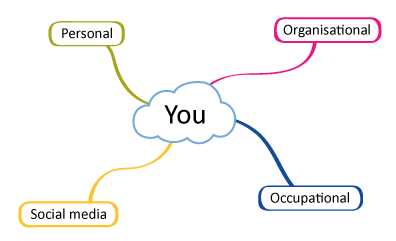6 What does your complete network look like?
It is useful to get an understanding of how your different networks, and the contacts within them, fit together. It will make it clearer where they cross and are connected. You will use your notes from Activities 3 and 4 to do this now.
Activity 5 Mapping your whole network
This activity helps you to create a ‘network map’. This is a visual representation of all your contacts, and how they might connect together.
Part 1
Use the names from Activities 3 and 4 to create a visual representation of each network in your notebook. This is not a drawing exercise, so do not worry about your artistic abilities. You are simply trying to show on paper how things ‘look’ inside your head.
Remember to include your online contacts from social media, if you are already actively engaged online.
One method of doing this is to use a mind map.
There are many ways to approach this. However, one way may be to put yourself in the centre, with links from you to each of the different networks, off of which you can write the appropriate names. As shown in Figure 16.
Or devise your own picture if you have an idea of your own.
Comment
When you think visually, you often think differently and see things you might not have realised before. The final step in the exercise, therefore, is to reflect on what you have learned about your existing network.
Part 2
Write down your answers to these questions in your notebook to help you think about what you have learned from your mapping. Do not feel constrained by the prompt questions though. Make a note of whatever feels significant to you.
- Are there some types of network you do not build or sustain from some reason? What might be the benefit if you did?
- Is the network imbalanced in some way? For example, do you have a great organisation network but know relatively few people outside your usual place of work? What effect might this have?
- What did you rank as your most and least important reasons for networking?
- Are there any strands of the network which need to be improved to help you to satisfy your main purpose in networking? What and why?
- What would you like to be able to say about your network in two years from now?
Comment
You may have been surprised by how extensive a network you have already developed. You will almost certainly have noticed some gaps or duplications in it. This is fine though, as it is a natural result of different ways we live our lives. The important thing is to consider how you can use and sustain your network or extend it.
Creating networks is one thing. Sustaining them is another. You need to be realistic, therefore, about how broad and deep a network you can manage at the moment. Being able to use networks skilfully and respectfully is the real challenge. You’ll look at this in the next section.


